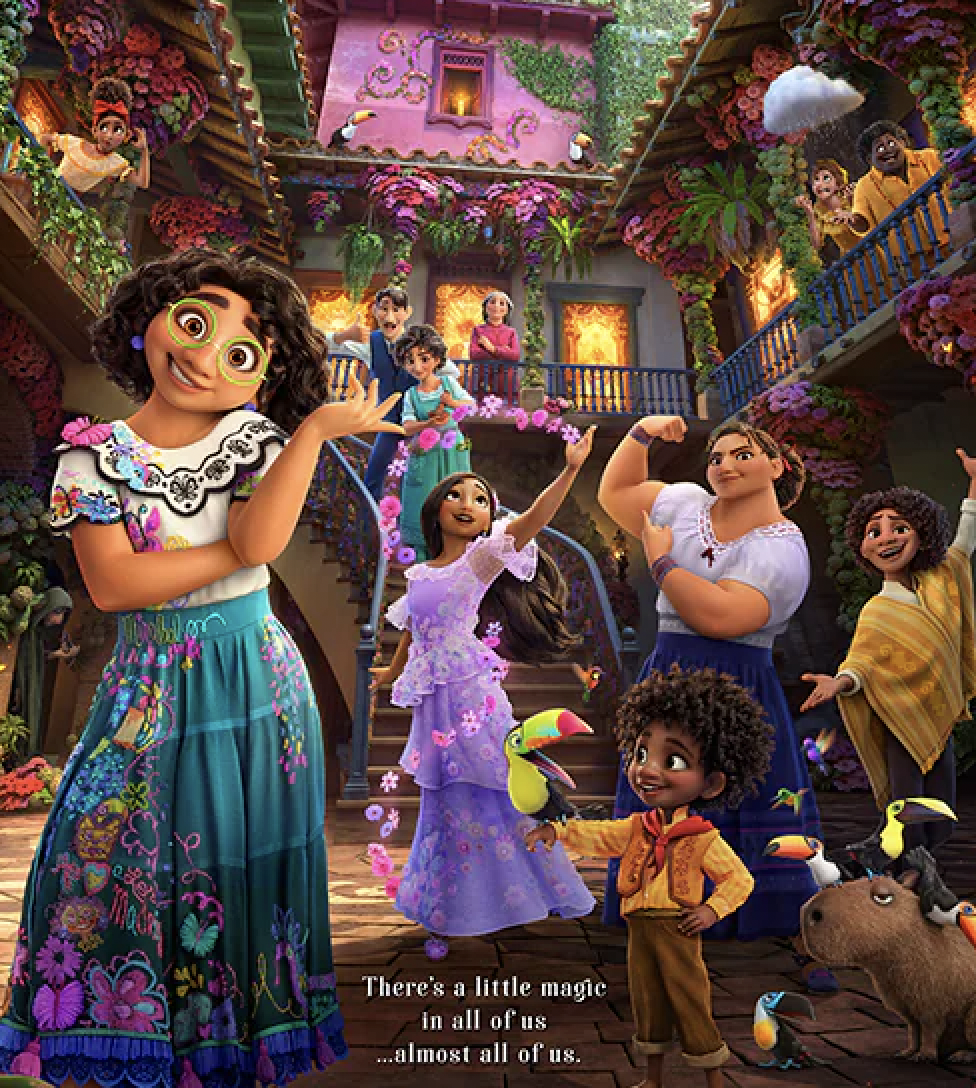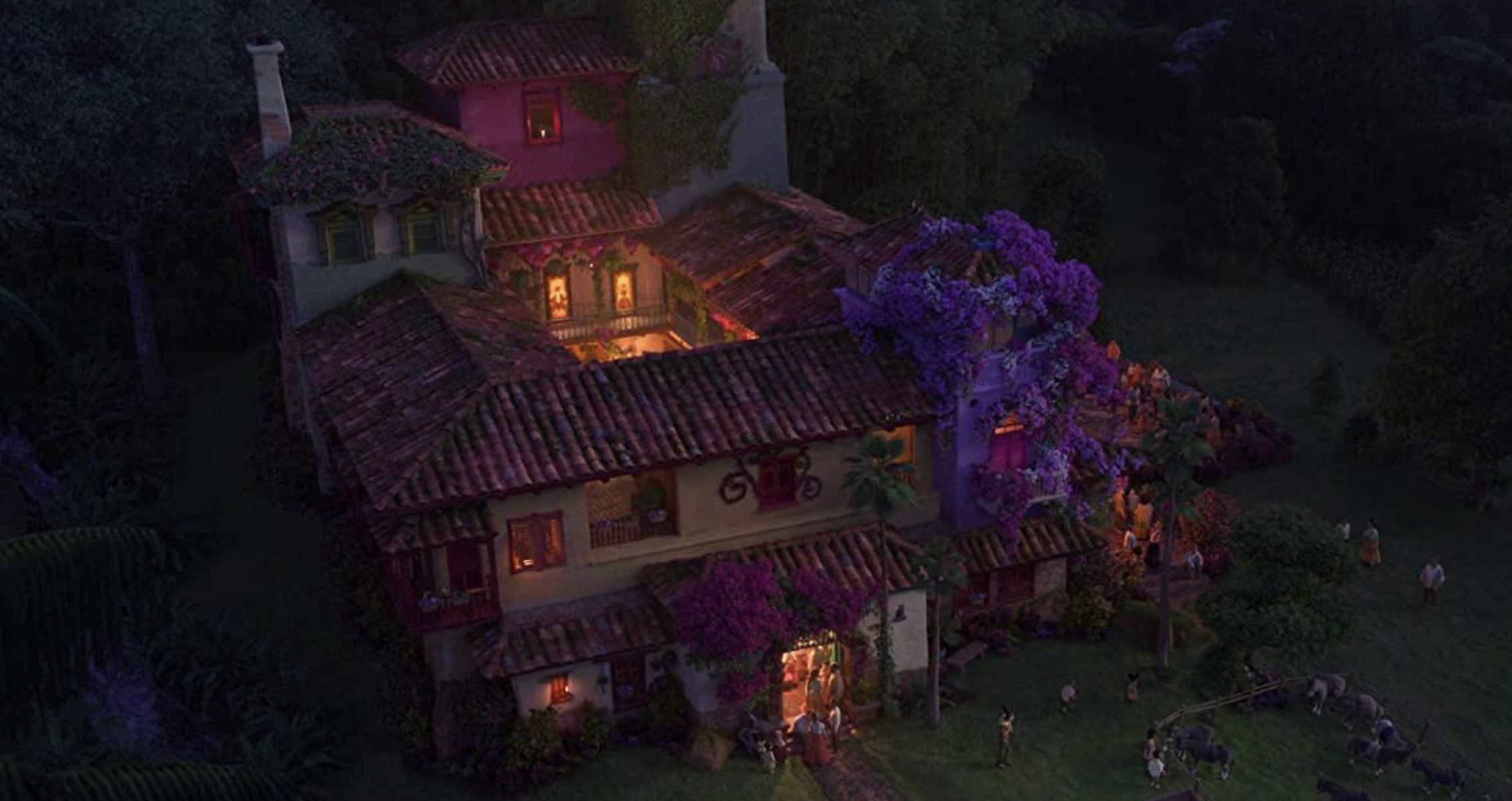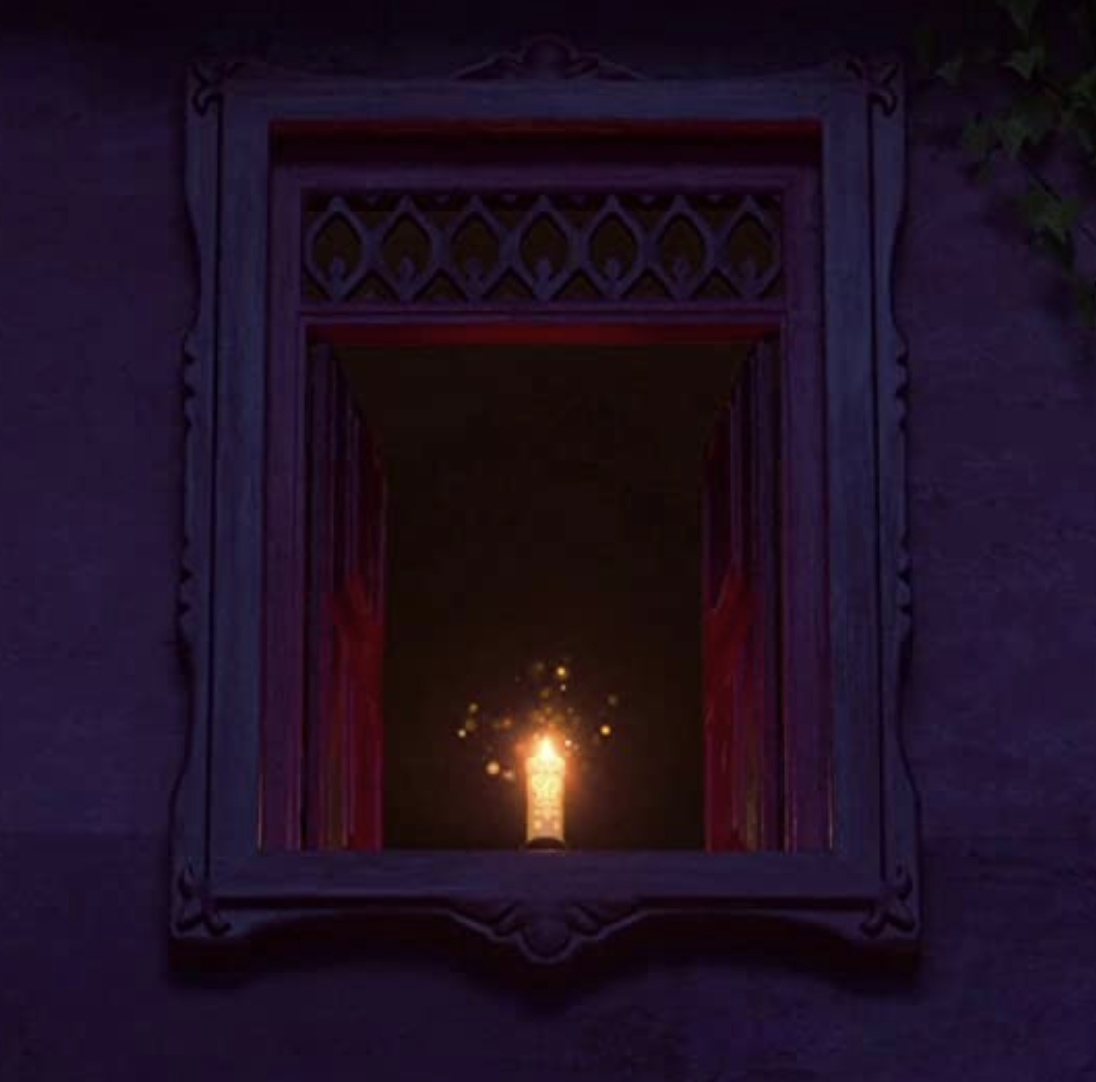HOLDING COURT: Encanto
Welcome to a new blog series here at The Fear of God. HOLDING COURT, a series by FoG Legal Counsel, Dave Courtney (get it?), where he plays both defense and prosecution, making airtight cases for the media he’s consuming; be it horrific, holy, or somewhere in the middle. Friends and FoGgers, all rise, because HOLDING COURT is now in session…
Encanto, a 2021 animated film from Walt Disney Studios, is a richly layered and finely textured cultural narrative which follows the Madrigal family living in a fictional Colombian Village. It explores the emerging conflict that presents itself within the functioning “familia”, connecting a storied past to present hopes and struggles. At the center of this family stands Alma Madrigal, the decisive Matriarch who holds the secret struggles of their past captive to a need to protect and preserve the larger familia against the horrors of their forgotten history.
One of the recognizable traits of Encanto is the magical realism, a literary genre that many believe, at least in the cultural sense (it technically came from Germany), was birthed in Colombia and which ties the physical and the spiritual world together. The film is influenced by an author often refered to as the father of magical realism, Gabriel García Márquez and his beloved book 100 Years of Solitude, with Encanto detailing how somewhere in the past a miracle occurred that gave light to the candle which remains eternally lit within the walls of their sentient “Casita”, the house in which the unnamed spirit or God which is the source of this miracle dwells. To occupy this house is to then dwell with the spirit that holds the familia together from one generation to the next, honoring and remembering the miracle that was once given and which continues to sustain their hopes and dreams for a better tomorrow. One of the key ways they do this is through a grand ceremonial and celebratory Tradition where each young child born to the larger family is submitted to a rite of passage, communing with the spirit or god in the hopes of obtaining a blessing, the continued manifestation of this miracle in the present by way of the giving of a super-natured gift (such as strength or beauty) that then comes to define who they are as part of the family, thus keeping the miracle alive through their use of these distinctive traits and talents.
Tensions surface when Mirabel, the youngest daughter within the larger familia, fails to receive a gift from the spirit/god. This leads her to be rejected and ostracized out of fear that the miracle might cease, the candle will go out, and that they will no longer be protected from the outside world. Perhaps even more relevant is the fear that witnessing this failure to receive a gift might cause some to begin to doubt the power of the miracle, threatening the unity of the familia and exposing the hidden history. From the outside looking in, seeing reality from this unique vantage point, Mirabel is able to observe certain truths about their existence the other family members remain blind to, raising her up as a prophetic voice warning about the potential dangers of continuing to live as they are and refusing to confront the truths of their past. A refusal to address the problems that do exist within the familia and which are already threatening their unity could bring about a future colored by visions of cracks appearing in the foundation, in the Casita, and a candle which loses its flame.
There is a specific scene in Encanto where, faced with the apparent loss of the spirit’s presence and the cracking of their foundation, Mirabel, who is blamed for the family’s present and growing misfortune, informs their Matriarch that “I am not the reason the light is going out, you are.” This represents a crucial turn in the story, featuring the rejection of the prophetic voice, the exposing of hidden truths, and the giving of fresh revelation. This moment is less a point about celebrating the strength of the liberated individual and of youthful resistance than it is a recognition of what it means to live together in the spirit, in unity with one another across generations and differences.
Rooted in Colombian Tradition and built using Colombian stories, customs and culture, we discover a world in the magical realism of Encanto that is deeply connected to a belief in a greater spiritual reality that informs their lives. This forms a crucial point for engaging with Encanto as someone, speaking personally, who is largely unfamiliar with the culture it explores. From this connection to the spirit flows a rooted sense of the collective, the familia, an image that, as the films diverse cast suggests, represents the distinctiveness of the real world coffee region, boasting a powerful mix of ethnicities and peoples which make up the larger community. There is a world where this same story is told raising up the empowered individual as the most important facet of its liberating message, seeing Mirabel freed from the shackles of the outmoded ways of the older generation by way of her youthful zeal and self determination. What we discover here is a story about the ways in which the individual is defined in relationship to the other, forming their identity within the familia and in light of Tradition and History, moving towards newness and change together. Change happens when we are rooted in history, Tradition, community, and an ever-growing and expanding understanding of the limitless bounds of the familia. Encanto is a story about locating the self within the whole, of finding one’s identity in the strength of our shared foundations. As these cultural assumptions play into an embrace of the shared spirit as something that challenges our view of the world in which we co-exist, this continues to show just how these shared foundations can broaden our perspective when it comes to being included in the familia.
Seeing this film in this way and letting it challenge some of my own assumptions about how the world works awakened something within me when it comes to embracing this recent Christmas season as a Christian. At the heart of this film sits a candle and a single flame. In Colombian Tradition this belongs to a Christmas celebration called Little Candles Day (velitas) which, beginning on December 7th as a stark example of syncretism, brings together Indigenous, colonial and Jewish histories in the shared image of the Puma and in the lighting of the candle as that which holds the horrors of this world at bay. The flame and the accompanying lights of the celebration mark the remembrance of the miracle given by the spirit to the people in the form of hope in times of darkness; a time of uniting our story with the story of the divine presence that permeates this existence.
The direct historical context for the story of Encanto is the 1000 Days War, a civil war that devastated the Colombian peoples and which still today lingers in their memory through generations of voices and experiences. In the film we see a younger Alma fleeing the violence and establishing this protected place (literally rendered “Charm”) hidden deep within the forest as part of a long tradition of belief in pueblos magicos (magical places) and marked by the miracle of this magic candle given at the riverfront in an encounter with the Divine. In the face of death and enveloped by darkness the light of the candle gifts them new life, something which the familiar symbol of the yellow butterfly, a token symbol in 100 Days of Solitude and a recognizable image within Colombian culture and the film, evokes.
The story then is built around a place where heaven and earth meet, where natural and supernatural are not separate ideas but part of the same - where the story of the physical world and the spiritual world are intertwined. The candle is lit by the giving of a miracle, the invading presence and inevitable witness of the spirit that is the source of their life and ability. The source of this miracle though is symbolized in the house itself, a physical structure in which the spirit dwells. As that foundation cracks under the pressures of a life lived in tension to this miracle, the light that seems to guide them, the memory of this miracle and hope it represents, begins to fade, threatening to disconnect the family from their history and the tragedy it contains.
In a very real sense this echoes the story of the Exodus and the ensuing exile in the Jewish scriptures, which follows a people once freed from violence and oppression but who have since forgotten the meaning and witness of this miracle, of God’s saving work. Once guided by a pillar of light they find themselves wandering and lost in the desert, the seeming dimming of the light beginning to foster questions of lost magic, feelings of being forgotten, and sparking fear of losing their connection to the source of this miracle. It is into this history that we find prophets being raised to help them remember who they are and what they were freed for. Memory plays a crucial role in the story of the ongoing transformation and regeneration of Israel within this prophetic Tradition, with long-standing practices of retelling and recontextualizing their story for future generations becoming necessary tools for locating the challenges of the present within their shared history, as well as connecting the larger family to the memory of the miracle.
It is from within this story of exodus and exile that we also arrive at the Christian celebration of Christ symbolized during Advent in the Christ Candle, which holds peace, faith, hope and joy together as a picture of the incarnation. Christ represents the embodied miracle, the retelling of the Exodus story through the story of His own life ministry, fleeing Egypt and the killing of the firstborns, moving through the waters of baptism (the Red Sea), into the desert where he faces similar temptations, up the mountain where, like Moses, he gives the law (the beatitudes), and descending the mountain to dwell in their midst as the restored temple, declaring the hope of new creation reality in the midst of the darkness.
What is interesting to note about the story of Encanto is the way the experience of this liberating miracle eventually finds the family moving towards a life of seclusion, isolation, and exclusion. The town is founded deep in the forest and sealed off from the outside world by the surrounding mountain. They can’t leave and others can’t arrive. In the creation narrative of Genesis we begin on a holy mountain with the river, the source of life, flowing outwards from its elevated position and connecting with four distinct rivers before continuing to water the whole of the earth with the presence of the gift giving spirit. This is the nature of such spaces, not imagined as some secret and exclusive locale intended to isolate us from the horrors of the real world, but a space meant for renewal and participation; a space intended to call us out into the whole of creation, bearing witness to a greater vision of reality. The question that lies at the heart of the creation story, then, is the question of God’s presence, how it is that God dwells within the created order in the face of disorder or chaos. The way of imagining this, and actualizing this for the Jewish people, was the building of the tabernacle and the temple. Like the people in Encanto, the question that permeates the prophetic witness within the story of Israel is the question of what it means to occupy this space then as a liberated people. The tendency when faced with the reality of this world is to want to escape it. This is what the promise of liberation intends to do, to move us from where we are to somewhere different. The much harder task is to see the vision of this liberating space as restorative, as an invitation to then take up residence within the world and to reimagine a better way as part of the new creation; to, in fact, see the new creation as the broken parts of our world being remade and restored in the image of God. The problem that Mirabel addresses is the family’s persisting isolation, something Alma has fostered out of fear of losing their place within the miracle’s blessing. It’s important here to note that Alma is not a villain, she has simply misplaced her hope for the familia in light of her fear. Thus for her the miracle continues to depend on the demonstration of these exclusive gifts, these identity-shaping markers, that show them to be part of the family and show the God/Spirit to be present. Their understanding of the miracle, misplaced as it is, keeps them hidden from the memory of the old horrors rather than enabling them to engage with the possibility of newness in the present.
In the Christian sense, Jesus arrives within this same prophetic tradition, challenging the peoples’ perception of identity, belonging and participation in the family of God. Just as the Casita crumbles and is thus restored with a renewed and broadened vision of what it means to be a familia, so does Jesus imagine the Jewish temple’s destruction and restoration in a similar sense of newness being birthed from within the created order. The temple is shaken precisely so that the familia can move towards greater participation within the world, the mountain in Encanto, centered as it is on the image of the river, cracking so that the gift-giving presence of the spirit can flow out into the world revealing the truth of who we are to a hurting world. It is a picture of the spirit no longer contained in the Casita, but now written on the hearts of the people as children born of the same spirit. This is what Mirabel ultimately sees when she looks in the mirror. She sees the miracle embodied not in outward signs of identity or contained within a building, but rather made alive in the embodied self, in our Christ-likeness. In this mirrored image she sees the gift of God with us made visible, and this revelation empowers her to then desire to reveal this same truth to others in ways they could not see themselves. This becomes a powerful picture of the spirit’s transformative and restorative work taking place within our lives and in our communities, beckoning us to consider not only that we are born as children of the spirit, of God, but also what it means to be children of God as we live into this calling as participants in the familia.
What’s striking and exciting to consider with Encanto is how in the Christian story - built as it is on Jewish expectations of God’s promised dwelling amongst the people and the peoples’ faithful abiding with God as they take root in the land and live as a liberated people - we begin on the mountain and we end on the mountain, with Christ invading the story in the middle of history to bring good news and the great joy of God-with-us in the darkness. Here we gain this picture of Christ ascending and Christ descending, bringing with Him the authority to declare the whole of creation as the space where heaven and earth meet. As it was in the creation story of Genesis, we find in the new creation story the call to then move outwards, to fill the earth with a renewed sense of this same magical realism that now informs our perspective. The same spirit in Encanto, grounded as it is in the ancient Indigenous Traditions of Colombia, as part of a shared foundation and an interconnected story, is demonstrated in the candles of Hanukkah and Advent, moving us towards ongoing transformation as we engage with what is a time of waiting and anticipation in this already-not yet reality. And as we wait we remember. We remember the gift of the miracle that once invaded history and which continues to witness to the spirit’s continued presence amidst the darkness.
And as we remember, we participate.
We participate, recognizing the miracle that gave flame to the candle, the light that exposed the darkness and which now beckons us from the what if, to the hopeful proclamation of what is. That God and Spirit simply “is” even when it seems difficult to fill in the blank forms a faith big enough to carve a path through the mountain towards the imagining of a better world, one built around this beautiful portrait of the familia that Colombian culture embodies for us and one carried forward by its persistent vision of unity as we grow in our understanding of the familia’s reach.






